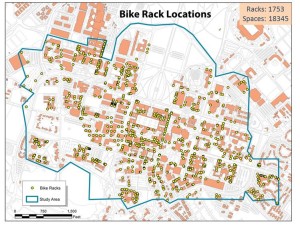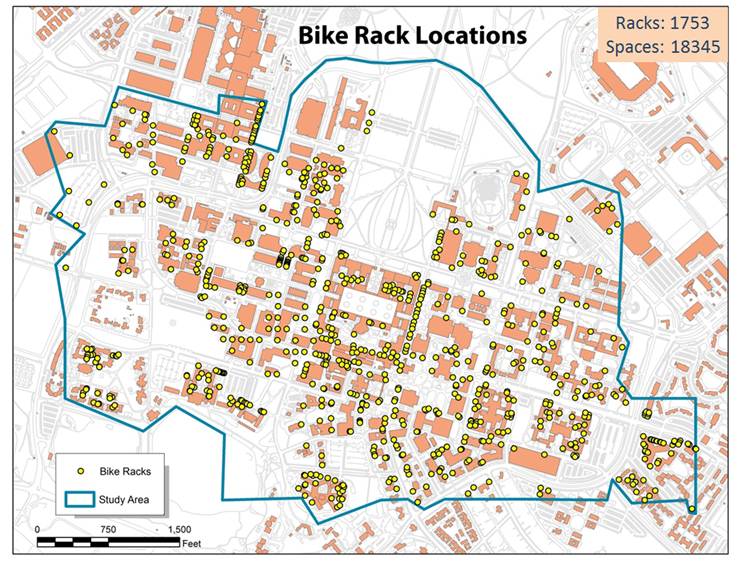Correction: In a previous version of this article, The Daily attributed a graphic to Ariadne Delon Scott. In fact, the graphic should have been attributed to Branner Earth Sciences Library. The Daily regrets this error.
Parking and Transportation Services (P&TS) has added 500 bike racks across Stanford annually over the last two years in response to a 2011 study mapping the density of bikes parked on campus. Currently, the University has 18,345 bike parking spaces, distributed across 1,753 separate bike racks.

Despite efforts to improve bicycle facilities and infrastructure– which has been recognized by the League of American Bicyclists with a “Platinum” award in both 2011 and 2012– cyclists have continued to express frustration about the distribution and location of bicycle parking spaces on campus, citing resulting issues like a large number of bike thefts.
“It’s hard to get a space on a bike rack whenever I need one,” said Clarence Chio ’14, resident computer consultant in Cardenal.
“It’s just a bad situation,” agreed Roxy Carbonell ’14. “If I had had a bike rack available, I could have locked my bike to one and wouldn’t have had it stolen.”
Space limitations constitute a principle obstacle to adding new bike racks to campus, according to Ariadne Scott, the University’s bicycle program coordinator. Scott cited the lack of space around the Gates Computer Science Building and the Hewlett Teaching Center as an example of a constraint on P&TS’s efforts to meet a surge in demand for bike racks.
“Some of the areas, like Gates and Hewlett, we continue to study since there are limitations with adding racks due to space– everyone wants to park close to the building,” Scott said.
“You have to make sure circulation is not compromised,” she added. “We also have racks on the front and sides of the building, and we have capacity there, but people who pull up late to class will just kickstand-park their bikes, lock and go to class. If they walked a few feet away, they would find a parking space.”
Reconsidering how bike racks are laid out might provide an alternate solution for areas– like those by Gates, Huang and Y2E2– that suffer from limited space and high bike traffic, according to Scott.
Over the past two years, the University has been attempting to address areas that a 2011 study revealed had a high demand for bike parking spaces. The study was initiated by staff at the Branner Earth Science Library, as a part of their geospatial program.
“It was actually a student who started this as a project, which was funded through a grant paid by Stanford University Libraries,” Scott noted.
Most of the study was conducted using geospatial maps already in the library’s possession. This was effective, according to Scott, because “it is very costly to collect data about this.”
Now, P&TS has a map of the bike racks on campus updated as time allows.
“Our study concluded that the highest density of bikes parked on bike racks was around the Main Quad, Huang, Y2E2, Packard, Gates, Beckman and Clark Center,” Scott said.
“There’s a lot of expansion at the Knight Management Center, where we’ve added capacity,” she added. “We’ve also done a lot of renovation along Panama Mall, in front of the d.school [Design School], and at the same time, in addition to bike parking, we’re adding bike lockers, tailored towards people commuting by bike.”
University administrators hope that this new distribution of racks will help bring down bike theft figures from the 329 bikes reported stolen last year. The Department of Public Safety has also recently announced a bike theft focus group of officers that will help study the problem as well.
One of the main focuses of the program has been to replace older styles of bike racks with the newer kind, called the “lightning bolt” design, according to Scott. The goal is to replace all current bike racks with new “lightning bolt” style bike racks in the next five to seven years.
“There are multiple styles of bike racks– the lightning bolt one is the kind you see in the Main Quad in bike parking areas,” Scott said. “Athletics has a different style rack, a triangular one. Old-style racks are in a lot of the housing areas.”
The University bicycle program does not manage bike racks in Student Housing.
“Housing takes care of their own racks,” Scott said. “We do make recommendations to them, though.”
